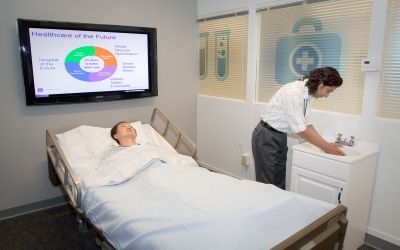GE Healthcare's Smart Patient Room to Begin Data Collection

GE Healthcare announced today that the Smart Patient Room pilot at Bassett Medical Center has been approved by the sites Institutional Review Board to begin data collection. The innovative technology solution was installed as part of GEs healthymagination initiative with the goal of helping healthcare providers to reduce patient safety risks and improve patient outcomes.
"GE is developing a unique solution for the healthcare industry that helps hospitals and staff identify and mitigate patient safety risks while offering meaningful solutions to improve patient outcomes," says Jan De Witte, president and CEO of GE Healthcare Performance Solutions. "GEs real-time, adaptable solution will provide actionable data to healthcare providers regarding patient safety and potential medical errors which in turn will affect the necessary behavioral changes to avoid preventable errors."
With the integration of this new technology into existing hospital rooms, the Smart Patient Room solution is designed to provide clinicians with real-time monitoring for patient risk and the ability to intervene via gentle notification. The system is designed to track protocol adherence such as proper hand hygiene compliance before and after interacting with a patient, periodic clinical rounding, and monitor for increased risk of patient fall.
"Patient safety is a concern for hospitals across the U.S., as more patients enter the health system," says William Streck, MD, President & CEO, Bassett Medical Center. "At Bassett we are very excited to be working alongside GE Healthcare and GE Global Research to design and pilot what is meant to be an industry solution for hospitals to identify and mitigate patient safety risks and improve patient outcomes."
The Smart Patient Room solution is being developed at GEs Global Research Center in Niskayuna, N.Y. and currently being piloted at Bassett Medical Center, a 180-bed, acute care inpatient teaching facility in Cooperstown, N.Y. The technology is intended as a flexible solutions platform designed to meet the needs of the specific hospital system.
According to the Institute of Medicine, medical error is the eighth leading cause of death in the U. S., accounting for an estimated 44,000 to 100,000 preventable deaths per year. Falls alone cost the U.S. healthcare system $1 billion annually, according to the American Hospital Association.
The Smart Patient Room can collect real-time information from the system to generate actionable data to manage clinical workflow, and uncover opportunities for influencing process and behavioral changes to create a safer patient environment.
The Guardians of Animal Health: Who Are Veterinary Infection Preventionists?
March 21st 2025Veterinary infection control experts Leslie Kollmann, BS, AAS, CVT, CIC, Denise Waiting, LVT, and Leslie Landis, LVT, BS, discuss challenges, zoonotic disease risks, and the importance of education, collaboration, and resource development in animal care facilities.
The Latest on CLABSIs and CAUTIs: Evidence-Based Approaches for Infection Prevention
February 27th 2025Health care–associated infections like CLABSIs and CAUTIs threaten patient safety. Learn evidence-based strategies, new technologies, and prevention protocols to reduce these infections and improve outcomes.
Resilience and Innovation: The Pivotal Contributions of Black Americans to Health Care and Medicine
February 24th 2025During Black History Month, we honor the resilience and contributions of Black medical professionals in health care. Despite barriers, they have led transformative changes, advocating for equitable access and medical excellence. Recognizing their impact ensures a more inclusive health care future for all.
Glove Usage Guideline: From The Joint Commission, CDC, and World Health Organization
February 17th 2025Proper glove use is crucial in health care settings to prevent infections. Guidelines from TJC, CDC, and WHO stress correct selection, usage, and disposal to minimize health care–associated infections (HAIs) and cross-contamination risks. Infection preventionists (IPs) play a key role in educating staff, enforcing compliance, and improving patient safety through standardized glove practices.